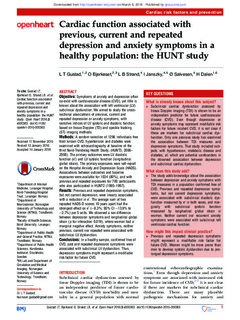Cardiac function associated with previous, current and repeated depression and anxiety symptoms in a healthy population: the HUNT study.
Peer reviewed, Journal article
Permanent lenke
http://hdl.handle.net/11250/2381820Utgivelsesdato
2016Metadata
Vis full innførselSammendrag
Objective: Symptoms of anxiety and depression often co-exist with cardiovascular disease (CVD), yet little is known about the association with left ventricular (LV) subclinical dysfunction. We aimed to study the cross-sectional associations of previous, current and repeated depression or anxiety symptoms, with sensitive indices of LV systolic and diastolic function, based on tissue Doppler (TD) and speckle tracking (ST) imaging methods.
Methods: A random selection of 1296 individuals free from known CVD, hypertension and diabetes were examined with echocardiography at baseline of the third Nord-Trøndelag Health Study, (HUNT3, 2006–2008). The primary outcomes were LV diastolic function (e′) and LV systolic function (longitudinal global strain). The primary exposures were self-report on the Hospital Anxiety and Depression Scale (HADS). Associations between outcomes and baseline exposures were available for 1034 (80%), and with previous and repeated exposures for 700 participants who also participated in HUNT2 (1995–1997).
Results: Previous and repeated depression symptoms, but not current depression, were linearly associated with a reduction in e′. The average sum of two repeated HADS-D scores 10 years apart had the strongest effect on e′ (−8.3%; 95% CI −13.9% to −2.7%) per 5 units. We observed a sex difference between depression symptoms and longitudinal global strain (p for interaction 0.019), where women had a marginal negative effect. Anxiety symptoms, neither previous, current nor repeated were associated with subclinical LV dysfunction.
Conclusions: In a healthy sample, confirmed free of CVD, past and repeated depression symptoms were associated with subclinical LV dysfunction. Thus, depression symptoms might represent a modifiable risk factor for future CVD.
